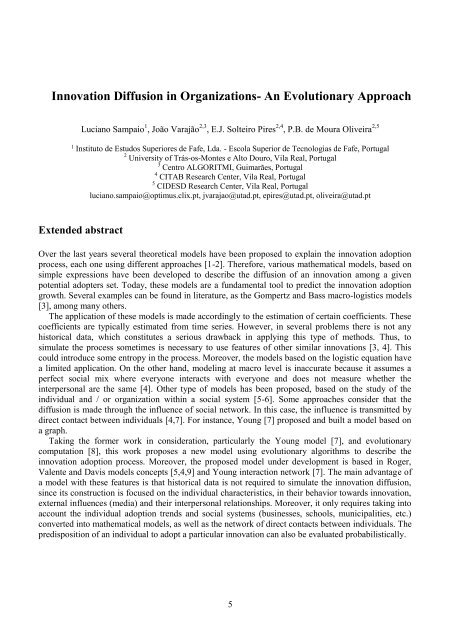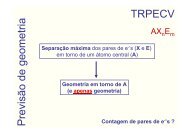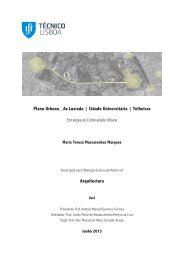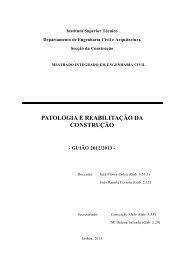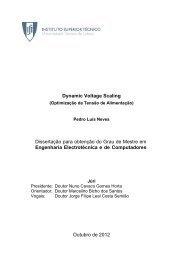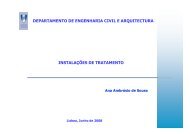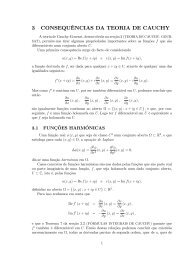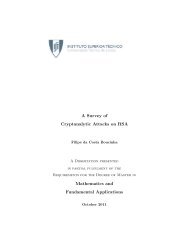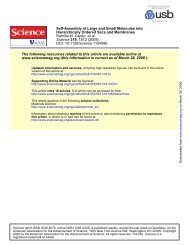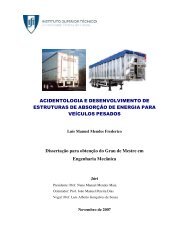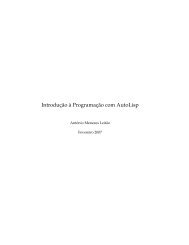Untitled - Universidade de Lisboa
Untitled - Universidade de Lisboa
Untitled - Universidade de Lisboa
Create successful ePaper yourself
Turn your PDF publications into a flip-book with our unique Google optimized e-Paper software.
Innovation Diffusion in Organizations- An Evolutionary Approach<br />
Luciano Sampaio 1 , João Varajão 2,3 , E.J. Solteiro Pires 2,4 , P.B. <strong>de</strong> Moura Oliveira 2,5<br />
1<br />
Instituto <strong>de</strong> Estudos Superiores <strong>de</strong> Fafe, Lda. - Escola Superior <strong>de</strong> Tecnologias <strong>de</strong> Fafe, Portugal<br />
2 University of Trás-os-Montes e Alto Douro, Vila Real, Portugal<br />
3 Centro ALGORITMI, Guimarães, Portugal<br />
4 CITAB Research Center, Vila Real, Portugal<br />
5 CIDESD Research Center, Vila Real, Portugal<br />
luciano.sampaio@optimus.clix.pt, jvarajao@utad.pt, epires@utad.pt, oliveira@utad.pt<br />
Exten<strong>de</strong>d abstract<br />
Over the last years several theoretical mo<strong>de</strong>ls have been proposed to explain the innovation adoption<br />
process, each one using different approaches [1-2]. Therefore, various mathematical mo<strong>de</strong>ls, based on<br />
simple expressions have been <strong>de</strong>veloped to <strong>de</strong>scribe the diffusion of an innovation among a given<br />
potential adopters set. Today, these mo<strong>de</strong>ls are a fundamental tool to predict the innovation adoption<br />
growth. Several examples can be found in literature, as the Gompertz and Bass macro-logistics mo<strong>de</strong>ls<br />
[3], among many others.<br />
The application of these mo<strong>de</strong>ls is ma<strong>de</strong> accordingly to the estimation of certain coefficients. These<br />
coefficients are typically estimated from time series. However, in several problems there is not any<br />
historical data, which constitutes a serious drawback in applying this type of methods. Thus, to<br />
simulate the process sometimes is necessary to use features of other similar innovations [3, 4]. This<br />
could introduce some entropy in the process. Moreover, the mo<strong>de</strong>ls based on the logistic equation have<br />
a limited application. On the other hand, mo<strong>de</strong>ling at macro level is inaccurate because it assumes a<br />
perfect social mix where everyone interacts with everyone and does not measure whether the<br />
interpersonal are the same [4]. Other type of mo<strong>de</strong>ls has been proposed, based on the study of the<br />
individual and / or organization within a social system [5-6]. Some approaches consi<strong>de</strong>r that the<br />
diffusion is ma<strong>de</strong> through the influence of social network. In this case, the influence is transmitted by<br />
direct contact between individuals [4,7]. For instance, Young [7] proposed and built a mo<strong>de</strong>l based on<br />
a graph.<br />
Taking the former work in consi<strong>de</strong>ration, particularly the Young mo<strong>de</strong>l [7], and evolutionary<br />
computation [8], this work proposes a new mo<strong>de</strong>l using evolutionary algorithms to <strong>de</strong>scribe the<br />
innovation adoption process. Moreover, the proposed mo<strong>de</strong>l un<strong>de</strong>r <strong>de</strong>velopment is based in Roger,<br />
Valente and Davis mo<strong>de</strong>ls concepts [5,4,9] and Young interaction network [7]. The main advantage of<br />
a mo<strong>de</strong>l with these features is that historical data is not required to simulate the innovation diffusion,<br />
since its construction is focused on the individual characteristics, in their behavior towards innovation,<br />
external influences (media) and their interpersonal relationships. Moreover, it only requires taking into<br />
account the individual adoption trends and social systems (businesses, schools, municipalities, etc.)<br />
converted into mathematical mo<strong>de</strong>ls, as well as the network of direct contacts between individuals. The<br />
predisposition of an individual to adopt a particular innovation can also be evaluated probabilistically.<br />
5


